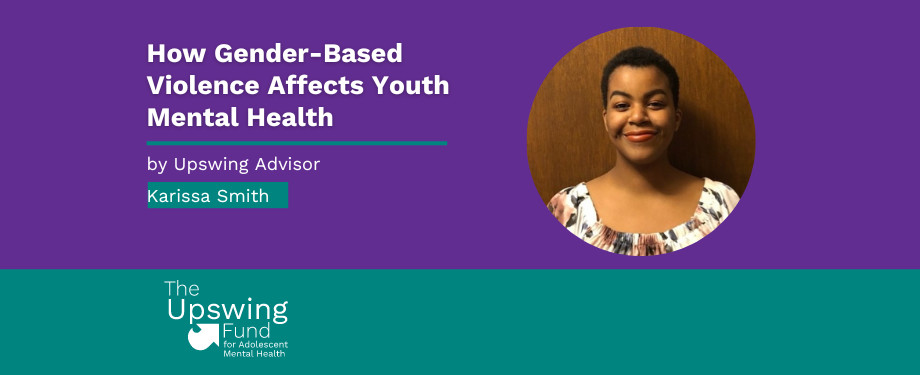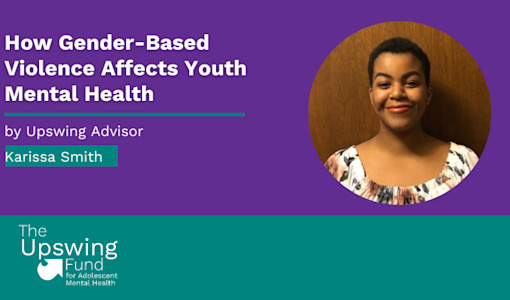

October 26, 2022 | Articles
How Gender-Based Violence Affects Youth Mental Health
Karissa Smith (they/them) is a confidential domestic violence advocate, violence prevention educator, and researcher. Their research aims to promote health equity and improve mental health outcomes of BIPOC and LGBTQ+ youth who have experienced gender-based violence.
Gender-based violence is an umbrella term that refers to acts of violence that are directed at an individual because of their gender identity. During the COVID-19 pandemic, there has been widespread discussion of youth mental health as it relates to isolation, loneliness, and the lack of accessible mental health care. However, there has been limited public recognition on the impact of gender-based violence on youth mental health. During the pandemic, reports of domestic violence have increased. The U.S. Health Department estimates that calls to the national domestic violence hotline increased by 19%. Gender-based violence takes many forms, including domestic violence, sexual harassment, stalking, emotional abuse, and financial abuse.
To be clear, anyone can experience gender-based violence, and anyone can perpetuate an act of gender–based violence. In this blogpost, I will focus on domestic violence and intimate partner violence (IPV). These terms are used interchangeably because both refer to forms of abuse done by past or current romantic and sexual partners. These forms of violence and behaviors can occur in romantic and/or sexual relationships.
Prevalence and Frequency of Gender-Based Violence
Gender-based violence occurs at alarmingly high rates. Approximately every 68 seconds a person will experience a form of gender-based violence in the United States. In Oregon, one in two women have experienced a form of interpersonal violence. Gender-based violence is experienced at much higher rates for gender diverse individuals. Resources traditionally focus on women. Recent data show that at least half of transgender and gender nonconforming individuals of color have experienced a form of gender-based violence. It is also important to note that Black and Indigenous women experience sexual and domestic violence at the highest rates across all racial/ethnic groups.
Despite the prevalence in which this occurs, we know little about the frequency—how often it happens. One of the key issues surrounding domestic violence is that marginalized groups are the most at risk to experience gender-based violence, but they are also the least likely to report it. Some barriers include fear of retaliation, distrust of law enforcement, disbelief that legal systems will protect them, and housing and financial concerns.
Mental Health Impacts to Survivors
Survivors of domestic violence experience adverse mental health outcomes, including a high risk of developing post-traumatic stress disorder, depression, and anxiety. Survivors of domestic violence are also at increased risk of suicidal ideation and behaviors. Additionally, survivors are more likely to turn to substances to cope with their distress, putting them at an increased risk for substance use disorder.
Considering these statistics, it is imperative that mental health researchers and providers begin to develop and disseminate accessible interventions such as technology-based and strength-based interventions.
The Important Role Direct Service Providers Play
LGBTQ+ and BIPOC survivors are more likely to report instances of gender-based violence to mental health service providers when they are affirming and culturally responsive. It is imperative that direct service providers and mental health professionals provide culturally responsive services. Domestic violence advocacy organizations should continue to create safe environments in which all survivors feel empowered to seek out help and report the violence if they choose to. For mental health providers, this means being aware of the varied cultural responses and social messaging that survivors may use when they disclose their experiences. For other direct service providers such as advocates, case managers or social workers, this means they need to be aware of the historical and ongoing mistrust of systems that continue to harm clients with marginalized backgrounds.
More Research Needs to be Done
Despite these statistics, there is still limited research on the frequency of domestic and sexual violence in BIPOC and LGBTQ+ communities. For example, the most recent U.S. Trans Survey, which includes questions regarding experiences of gender-based violence, was conducted in 2015. Although they are currently encouraging pledges to take the 2022 survey, this leaves a seven-year gap in available data on trans and gender diverse individuals’ experiences. To date, there has not been a comprehensive report and survey looking specifically at the experiences of interpersonal violence in Black communities and other communities of color. Even more concerning, there is currently no report that specifically examines and provides tailored interventions to address the high rates of violence that trans women of color experience. As both a direct service provider and researcher, I find this to be particularly alarming because marginalized communities experience unique needs and barriers.
Where to Go from Here
Addressing the mental health needs of survivors of domestic violence and unwanted sexual contact will require a multilevel approach. Firstly, not enough therapists receive comprehensive training on sexual trauma, the signs of relationship abuse, and how to deliver effective domestic violence interventions. The National Counselors Exam and the National Clinical Mental Health Counseling Exam does not require gender-based violence and abuse coursework/ knowledge to receive licensure. Moreover, there are limited interventions that are shown to improve the outcomes of BIPOC and LGBTQ+ survivors.
While there are several interventions aiming to address domestic violence such as Trauma-Focused Cognitive Behavioral Therapy (CBT-TF) and Exposure and Eye Movement Desensitization and Reprocessing (EDMR) there is still a large gap in services. Researchers and direct service providers note that survivors of domestic violence experience numerous barriers when seeking help. One key issue is that mental health services are largely inaccessible. Many domestic violence agencies, such as rape crisis centers, are unable to provide mental health services due to a lack of funding to support trained staff and offer free services.
Some things that could be done to address the problems stated above are:
• Incentivize graduate mental health programs to require coursework on healthy relationships and signs of abuse
• Provide community resource and crisis centers more funding so that they can provide mental health services
Ways to Get Involved and Learn More
Interpersonal violence is a public health crisis that needs to be addressed with a socioecological lens. One suggestion is to pass the Family Violence Prevention and Services Improvement Act. As of October 2021, it has been passed by the House of Representatives. Passing this bill would increase funding to domestic violence agencies and would help make mental health services more accessible to individuals who have experienced violence.
Mental health providers interested in learning more about intimate partner violence (IPV), particularly resources focused on helping BIPOC and LGBTQ+ individuals experiencing IPV, might find the below list a helpful starting point:
- Power and Control Wheel (National Domestic Violence Hotline)
- Intimate Partner Violence: Unnatural Power and Control Descriptions (National Indigenous Women’s Resource Center)
- The Northwest Network of Bisexual, Trans, Lesbian, and Gay Survivors of Abuse (The NW Network)
- Me too Resource Library (Me too.)
- Safety Planning: A Guide for Transgender and Gender-Non-Conforming Individuals who are experiencing Intimate Partner Violence and Sexual Violence (FORGE)


